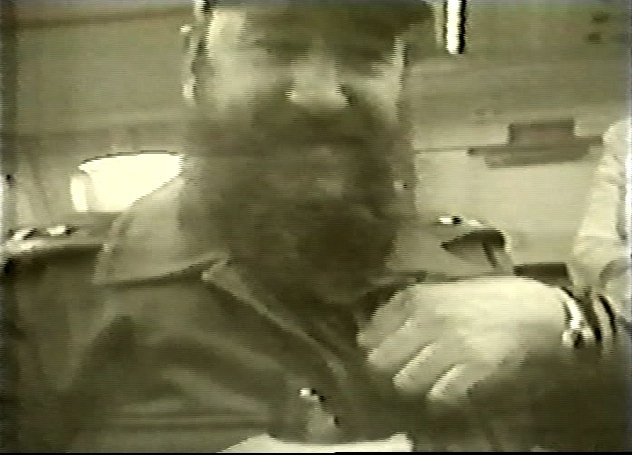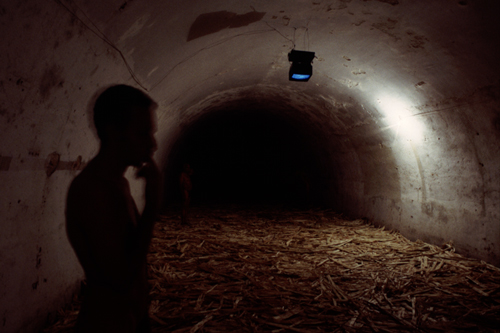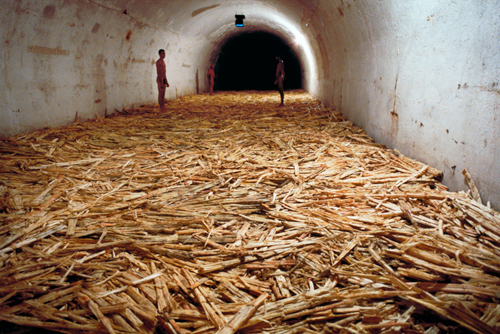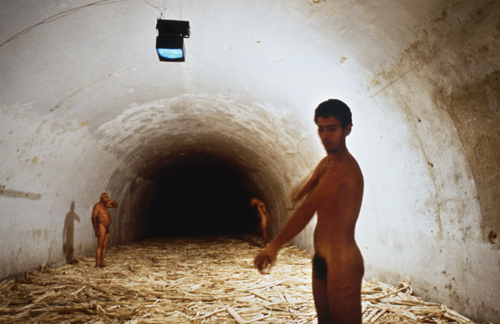Title: Untitled (Havana, 2000)
Medium: Video Performance – Installation
Year: 2000
Materials: Sugar cane bagasse, TV black and white monitor, Cubans, DVD discs, DVD players
Dimensions: 13.12′ x 39.37′ x 164.04′
Statement
Untitled (name of the city, year when the work was performed) is a series where the title maintains its structure but specifies, in every new work, the city and the year in which it is made so as to speak in terms of Specific Political Timing. On the political imaginary in the places in which they are held, the perspective from which the works are made is that of people not belonging to their context or having been part of the history that has built them. The works in this set intend to demystify the a priori political image on some given social spaces created by those who are alien to them. The need to change that image is experienced manipulating its political symbols par excellence. The superficial knowledge we have on the reality of a society alien to us is usually based on the information emerging from the diffusion of its stereotypes, on whose basis a preconceived idea is built which then takes hold of the collective conscience and models a state of opinion. The fact that the title of the series is Untitled – with the place and year in which it will be made within parenthesis – is an invitation to face a sociopolitical context which we do not actually know but of which we have an opinion. It is a call to understand the transience and fragility of definitions on contexts that are not our own, to understand that their reality is more complex than the information which we believe we have on it.
In the case of Untitled (Havana, 2000), the piece is a video performance installation made in one of the dark and damp vaults in the Cabana Fortress, a space which from times of the Spanish colonization until a few years before the exhibition, used to be a military jail for prisoners of conscience. The floor, covered with decomposed sugar cane bagasse, creates an instability which makes walking on it difficult. When entering the entirely dark space, a faint light can be seen at the end of it. It comes from a TV screen hanging from the roof, showing historical material with Fidel Castro’s image. Only when facing the entry again a series of erect male figures, naked in the dark, may be seen repeating gestures like bending down, rubbing or hitting parts of their bodies. After the inauguration, the piece was censored by Cuban authorities and it could not be repeated during the days the Biennial lasted, under the argument that male nakedness in public spaces is banned.
The work was conceptualized answering the topic suggested by the Biennial as the curatorial axis of the event “Closer to one another.” It intended to analyze the relationship between political leaders using the mass media to project a more human image by affecting vulnerability, and common citizens who have no way to amplify their vulnerability to have it change. Cuba, a place where leftist fantasies were projected, has projected itself in the political imaginary in the figure of Commandant in Chief Fidel Castro, while witnessing the much more difficult to understand reality of common citizens is obviated or avoided and does not always coincide with mythicized legitimization. The piece reflects this intentional “blindness” and, through a sensorial experience, tries to approach the spectator to a reality full of contradictions.
Exhibited
|
2015 |
|
|
56th International Art Exhibition: All the World’s Futures. La Bienalle. Venice, Italy. Curated by Okwui Enwezor. (Performance and Installation) November 20 – 22 |
|
|
2013 |
|
|
Superreal: alternative realities in photography and video. Museo del Barrio, Las Galerías, New York, United States. Curated by Rocio Aranda-Alvarado. (Documentation) February 6 – May 19 |
|
| 2010 | |
|
Tania Bruguera: On the political Imaginary (Survey Show). Neuberger Museum of Art, Purchase College, State University of New York. Purchase New York, United States. Curated by Helaine Posner. (catalog) (Performance and Installation) January 28 – April 11 |
|
|
2000 |
|
|
Uno más cerca del otro, VII Bienal de La Habana. Fortaleza de San Carlos de la Cabaña, Galería de Contraminas de San Ambrosio, Havana. Curated by Centro de Arte Contemporáneo Wifredo Lam. (catalog) (Performance) November 17 Note: After the inauguration, the piece was censored by Cuban authorities, first the artist changed the title from Ingenieros de Almas to Untitled (Havana, 2000) then she was informed that the piece would not be repeated during the days the Biennial lasted, under the argument that male nakedness in public spaces is banned. |
Documentation
Selected bibliography
(by alphabetical order)
Breerette, Geneviève “Tania Bruguera, le corps, la société et la politique,” Le Monde, Dec. 5, Paris, France, 2000.
Bruguera, Tania “Untitled (Havana, 2000),” Boundary 2 -an international journal of literature and culture vol. 29, no. 3, Fall, Edited by John Beverley, Text by various authors, Ed. Duke University Press, North Carolina, United States, 2002, (cover & illust.) pp. 34 – 47. ISSN 0190-3659.
_______________ “Postwar Memories,” By Heart / De Memoria -Cuban women’s journeysc in and out of exile,- Edited by María de los Ángeles Torres, Texts by various authors, Ed. Temple University Press, Philadelphia, United States, 2003, (ilust.) pp. 169-189. ISBN 1592130100.
Cembalest, Robin “Where Rube Goldberg Meets Kafka: At the Havana Bienal, concepts like political correctness and radical chic got all shook up,” ARTNews, vol. 100, no. 2, February, New York, United States, 2001, (illust.) pp.150 – 151.
Chambert, Christian “The 7th Havana Biennial,” The Nordic Art Review, vol. III, no.1/01, 2001, Stokholm, Sweden. ISSN 1404-207X (illust.) pp. 86-87.
Griffin, Jonathan “Tania Bruguera: Cuba, performance and society’s relationship to its history,” Frieze, Issue 118 October 2008. (ilust.) p 286 – 287 ISSN 9770962067014.
Höller, Silvia “The Every gesture is a political act,” Portraits. Silvia Höller and Gerarld Matt. Ed. Buchhandlung Walther König, Köln (illust.) p. 7 / p. 51. ISBN 3865600840
Israel, Nico “VII Bienal de la Habana,” Artforum Internacional, February, 2001. (illust.) pp.147 – 148.
Levin, Kim “Art and Contradiction at the Havana Bienal: Cuba Libre,” Village Voice, December 26, New York, United States, 2000.
Martínez, Rosa “Tania the Guerrillera,” 2001. Unpublished Bayliss, Sarah. “Putting on the lamb,” ARTnews, vol. 103, no.9, October, New York, United States, 2004, (illust.) p. 21 / pp. 164 – 167.
Posner, Helaine “Introduction,” Tania Bruguera: On the political imaginary, Ed Charta, Milano, Italy, 2009, (cover & illust.) pp.15 21. ISBN 9788881587643
Smith, Terry “What is Contemporary Art?” Part IV Countercurrents: South / North, chapter 9 The Postcolonial Turn,” Ed. University of Chicago. Chicago, United States (illust.) pp. 163 – 165. ISBN: 9780226764313
Turner, Grady “Sweet Dreams”, Art in America, New York, United States, 2001.
Villalonga, Yuneisky “Tania Bruguera; Her Place an Her Moment. Maintenant, Ici, La Bas [Now, Here, Over There],” Frac Lorraine. 2007 (illust.) pp.74 – 95. ISBN 9782911271113
Zaya, Octavio “Against the Forms of Power,” Culture and The Human Body, Prince Claus Awards 2008, (illust.) pp. 46 – 49.
Quotes
“(…) Bruguera scored a knockout with her work. It is rare that anyone, with such exact artistic means and such courage, exposes a difficult political and social situation from the inside.”
Christian Chambert, The 7th Havana Biennial, The Nordic Art Review, 2000.
“Tania Bruguera´s performance/installation in a pitch-black tunnel was the most memorable piece. Treading blindly for what seemed aeons in oppressive darkness on an instable mush of fermenting sugar can stalks, nearly overcome by the sickly sweet smell, you approached a faint ray of hope: the dim glow of a TV hanging overhead. On it was a video collage of Castro’s life. And as you turned back, all senses on total alert, you faintly perceived the presence of bare living bodies, endlessly rubbing their mouths or slapping their thighs. Some viewers saw a man and a woman, others insisted there were four males. Like Cuba itself, it was a total sensory experience-contradictory, illusive, and hard to fathom. It summed up the invisibility, the toxic presence, the history of exploitation, and the heart of darkness. “It’s like Cuba”, said the artist. “It’s sweet, it can be dangerous, it’s intoxicating.”
Kim Levin, Art and Contradiction at the Havana Biennial: Cuba Libre, Village Voice, December 26, 2000.
“(…) A long line formed outside the installation on opening day, as word quickly spread that Bruguera was among the Biennial’s most impressive artists.”
Grady Turner, Sweet Dreams, Art in America, Winter 2001
“All the artists are aware that what you can show abroad is different from what you can show at home, where censorship- and, consequently, self-censorship-remain looming problems. How -and how far- you can push the envelope is always in question. Tania Bruguera, a Cuban artist who has a flourishing international career, knew this when she assembled an installation for a dark, dank space in La Cabaña, which used to be a military prison. On the floor she spread sugar cane, which soon began to emit a rotting smell. Overhead, she installed a television monitor, which played a loop of familiar moments from Castro’s life. If the tape seemed subversive, it’s because the man himself evokes so much emotion-as does the specter of watching him get older, and older, and older. But that’s not, ostensibly, what caused the problem. On the Bienal’s opening weekend, Bruguera staged a performance in the installation. As visitors turned away from the monitor and their eyes adjusted to the obscurity, they saw four nude men making a series of repetitive gestures: rubbing themselves, wiping themselves, etc. Bruguera’s intention was to stage the piece once, but because many people were left ouside, she decided to repeat it a few days later. That morning, however, she received a call telling her not to. The military authorities in charge of La Cabaña had objected to the male nudity. “
Robin Cembalest, Where Rube Goldberg Meets Kafka, ARTNews, vol. 100, no. 2, February,2001
“(…) In Bruguera’s world, concepts like freedom, liberty and self-dermination are not abstract ideals, but achievements that write their effects on our physical forms.”
Heartney, Eleanor. Art In America, March, 2002. (Review). (Ilust.) pp. 131 132
“Bruguera’s early performances led to installations from which she absented herself physically but which forced the audience in to no less demanding positions. In Untitled (Havana), made for 2000’s Havana Biennial, she filled a dark, tunnel like space in a former military prison with a layer of rotting bagazo, or sugarcane husks. Visitors struggled over the pungent-smelling stalks, drawn towards a light at the end of the tunnel, which revealed itself to be a video playing footage of speeches by Castro. Only when turning back towards the entrance did they notice a number of naked male figures in the darkness, repeating gestures such as bowing, rubbing or slapping parts of their bodies. Reportedly because of the nudity, but more likely because the work potently described the abject and degrading relation between the subjects of power and its icons, the installation was shut down by the authorities after one day…”
Jonathan Griffin, Tania Bruguera: Cuba, performance and society’s relationship to its history, Frieze, Issue 118, October, 2008







